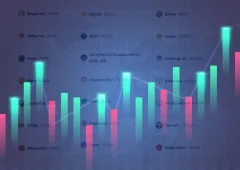Ripple Plans Major Expansion for RLUSD Stablecoin, Teases Upcoming Exchange Listings
09.01.2025 14:00 2 min. read Alexander Zdravkov
Ripple's president, Monica Long, has hinted that the Ripple USD (RLUSD) stablecoin will soon make its way onto major crypto exchanges.
In an interview on January 7, Long revealed that the company is actively working on expanding the availability of RLUSD and expects to make announcements soon. While she didn’t provide specifics, it’s clear that Ripple is pushing forward with listing RLUSD on prominent platforms in the near future.
Since its launch in December 2024, RLUSD has already found its place on several platforms, including Bitso, MoonPay, and Bullish. With a current market cap of around $71.8 million, the stablecoin has shown promising growth.
However, the majority of its trading volume is still concentrated on Bullish exchange, particularly through the RLUSD/USD Coin (USDC) and XRP/RLUSD pairs. Sologenic, a decentralized exchange, also contributes a smaller portion of RLUSD trading, handling about $3.4 million in daily volume.
Ripple has big plans for RLUSD, especially considering the rapid growth in its payment business. According to Long, Ripple’s payment solutions doubled in 2024, and the company sees RLUSD playing a crucial role in that success. She also expressed confidence in the future of stablecoins, anticipating a surge in demand as the crypto market continues to grow.
Looking ahead, Long also touched on Ripple’s prospects in the ETF space. With Ripple’s XRP potentially following in the footsteps of Bitcoin and Ethereum, she believes an XRP exchange-traded fund (ETF) could be approved soon. She pointed out that several firms, such as WisdomTree and Bitwise, have already filed for XRP ETF products and that she expects regulatory approvals to accelerate under the new U.S. administration.
-
1
Binance Expands Futures Platform with New High-Leverage Contract
16.05.2025 15:47 1 min. read -
2
Vitalik Buterin: Ethereum Must Be Ready to Replace Cash
27.05.2025 14:00 1 min. read -
3
XRP Price Prediction: Can CME Futures Propel XRP to $4?
26.05.2025 23:49 3 min. read -
4
Analysts Warn Bitcoin Is Easier to Attack Than Ethereum
18.05.2025 14:00 2 min. read -
5
WalletConnect Launches WCT on Solana with $3M Airdrop
25.05.2025 22:00 2 min. read
Solana Price Prediction: Trend Reversal and EMA Crossovers Favor Retest of $100
Solana (SOL) has gone down by 6% in the past week and although the token has recovered in the past 24 hours, technical indicators favor a bearish outlook. Trading volumes have gone up by nearly 18% as bulls managed to reverse an early sell-off during the Asian session. However, meme coins, an important segment of […]
Corporate Interest in XRP Surges as Firms Eye It for Treasury Reserves
A growing number of publicly traded companies are turning to XRP as a potential reserve asset, signaling a shift in how institutions view the utility of digital assets in treasury management.
Coinbase Brings Wrapped XRP and DOGE to Base for DeFi Integration
Coinbase has taken another step toward boosting cross-chain utility by introducing wrapped versions of XRP and Dogecoin on its Layer 2 network, Base.
Whale Activity Triggers Caution for Select Altcoins Amid Bitcoin Optimism
While Bitcoin continues to capture attention with its strong 2025 outlook, several altcoins may be facing near-term turbulence.
-
1
Binance Expands Futures Platform with New High-Leverage Contract
16.05.2025 15:47 1 min. read -
2
Vitalik Buterin: Ethereum Must Be Ready to Replace Cash
27.05.2025 14:00 1 min. read -
3
XRP Price Prediction: Can CME Futures Propel XRP to $4?
26.05.2025 23:49 3 min. read -
4
Analysts Warn Bitcoin Is Easier to Attack Than Ethereum
18.05.2025 14:00 2 min. read -
5
WalletConnect Launches WCT on Solana with $3M Airdrop
25.05.2025 22:00 2 min. read


